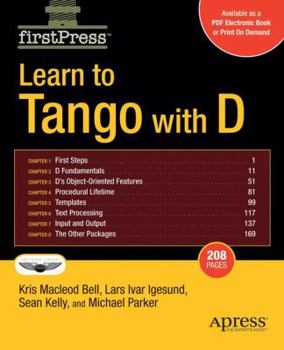Learn to Tango with D
Learning to Tango with D introduces you to the powerful D language, with special attention given to the Tango software library. A concise yet thorough overview of the language's syntax and features is presented, followed by an introduction to Tango, the popular general purpose library which you'll return to time and again when building your D applications.
Format:Paperback
Language:English
ISBN:1590599608
ISBN13:9781590599600
Release Date:February 2008
Publisher:Apress
Length:208 Pages
Weight:0.82 lbs.
Dimensions:0.5" x 7.5" x 9.3"
Customer Reviews
3 ratings
Excellent book that accomplishes its goals
Published by Thriftbooks.com User , 14 years ago
I found that this book strikes a very comfortable balance between adequately introducing the essential details of various important aspects of the D language and this version of a necessary "standard library". Given how recent the introduction of the D programming language is, and the relatively small size of its dedicated community, it should not be surprising that there are few published works defining the language and some of its optimal coding signatures. This book's goal is to teach the use of the Tango standard library for the D programming language. It is not meant as a comprehensive teaching guide to D itself! Within this limitation, it does succeed, admirably. Contrary to another reviewer's scathing criticism; I found that, while terse, the descriptions and examples set forth in this book are clear, hew closely to the point at hand, maintain elegance in their simplicity, and reveal only necessary aspects of complexity in context. To lambaste this generally excellent book for a personal disappointment regarding its scope, is inappropriate; and in any event, it obviously deserves well more than a mere one star. To that reviewer I respond: you are petty and have done the D language community a disservice in your churlishness.
I still can't dance very well!
Published by Thriftbooks.com User , 15 years ago
A short and sweet introduction to the D programming language, with the majority of the syntax covered. Some concise examples and of course, Tango documentation. There was a fairly negative review and I feel I should try and explain some of the (perceived) issues with the book. Firstly, the length. While this book clocks in at just under 200 pages, and that seems relatively short. Especially when the book is meant to cover the entirety of a programming language, there are a few things we should consider. This book does not teach you how to program, it assumes prior programming knowledge. Furthermore, As D is a new language, there is no official standardization, and the official language documentation is often short, with very specific details left out. Let us also not forget than K & R is just about 250 pages! The last few chapters of the book cover some of the Tango API. The Tango project is a community designed and maintained standard library replacement for D. It implements its own run-time and API set. Fixes a lot of the perceived bugs in the original, and no one can argue is a lot more robust than Phobos. Tango and D are both constantly moving targets, and I believe this book does a good job of documenting the core of each.
Solid introduction to D basics
Published by Thriftbooks.com User , 15 years ago
The first English-language book on D, Learn To Tango with D, is a no-crap quick ramp-up guide to the language and the popular Tango general-purpose library. Half of the 188 pages are an introduction to how D does things, while the other half walks through some Tango basics. It's written in a fast, loose idiom that doesn't try to teach you programming as much as it shows how to do your favorite C++ or Java tricks in D. This fills a need since the existing D documentation is rather technical and not well indexed, but it's not something the dedicated and curious engineer couldn't figure out for himself. After the basics, you're introduced to Tango. I should point out that D ships with a standard library called Phobos and that Tango is a (friendly) competitor to it. The two aren't mutually compatible at all, and you'll run into D code that uses each, so don't think you're getting the entire D story from this book. That said, Tango has neat ideas and a passionate community behind it, so you're not making any compromise on quality by using it. This section is a bit too high-level for my taste; it's an introduction, not a reference. While you can certainly get production-quality API docs from the Tango web site, don't expect the book to be one. Summing up, this book is for experienced C/C++/Java programmers who've heard about this D thing and want to see what it's all about. Those who prefer learning from source code or documentation won't really need this, and those who do need it will probably find no need to read it a second time. However, as the only book on D in the King's English, it's worth recommending solely on that basis. (Review text copied from my website.)





